belt CHEVROLET AVALANCHE 2007 2.G Owners Manual
[x] Cancel search | Manufacturer: CHEVROLET, Model Year: 2007, Model line: AVALANCHE, Model: CHEVROLET AVALANCHE 2007 2.GPages: 618, PDF Size: 3.25 MB
Page 1 of 618

Seats and Restraint Systems
....................... 7
Front Seats
.............................................. 9
Rear Seats
............................................. 19
Safety Belts
............................................ 21
Child Restraints
...................................... 45
Airbag System
........................................ 72
Restraint System Check
......................... 88
Features and Controls
................................ 91
Keys
....................................................... 93
Doors and Locks
.................................. 102
Windows
............................................... 116
Theft-Deterrent Systems
....................... 118
Starting and Operating Your Vehicle
....... 122
Mirrors
.................................................. 145
OnStar
®System
................................... 156Universal Home Remote System
.......... 159
Storage Areas
...................................... 170
Sunroof
................................................ 199
Instrument Panel
....................................... 201
Instrument Panel Overview
................... 204
Climate Controls
................................... 227
Warning Lights, Gages, and
Indicators
.......................................... 239
Driver Information Center (DIC)
............ 257
Audio System(s)
................................... 286
Driving Your Vehicle
................................. 351
Your Driving, the Road, and
Your Vehicle
..................................... 352
Towing
................................................. 408
2007 Chevrolet Avalanche Owner ManualM
1
Page 7 of 618

Front Seats..................................................... 9
Manual Seats................................................ 9
Power Seats............................................... 10
Power Lumbar............................................. 11
Heated Seats.............................................. 12
Memory Seat, Mirrors, and Pedals.............. 13
Reclining Seatbacks.................................... 14
Head Restraints.......................................... 18
Center Seat................................................ 18
Rear Seats.................................................... 19
Rear Seat Operation................................... 19
Safety Belts.................................................. 21
Safety Belts: They Are for Everyone........... 21
Questions and Answers About
Safety Belts............................................. 25
How to Wear Safety Belts Properly............. 26
Driver Position............................................. 26
Shoulder Belt Height Adjustment................. 34
Safety Belt Use During Pregnancy.............. 35Right Front Passenger Position................... 36
Center Front Passenger Position................. 36
Rear Seat Passengers................................ 37
Rear Safety Belt Comfort Guides................ 41
Safety Belt Pretensioners............................ 44
Safety Belt Extender................................... 44
Child Restraints............................................ 45
Older Children............................................. 45
Infants and Young Children......................... 48
Child Restraint Systems.............................. 51
Where to Put the Restraint.......................... 55
Lower Anchors and Tethers for
Children (LATCH).................................... 57
Securing a Child Restraint in a
Rear Seat Position................................... 65
Securing a Child Restraint in the
Center Front Seat Position....................... 67
Securing a Child Restraint in the
Right Front Seat Position......................... 68
Section 1 Seats and Restraint Systems
7
Page 17 of 618
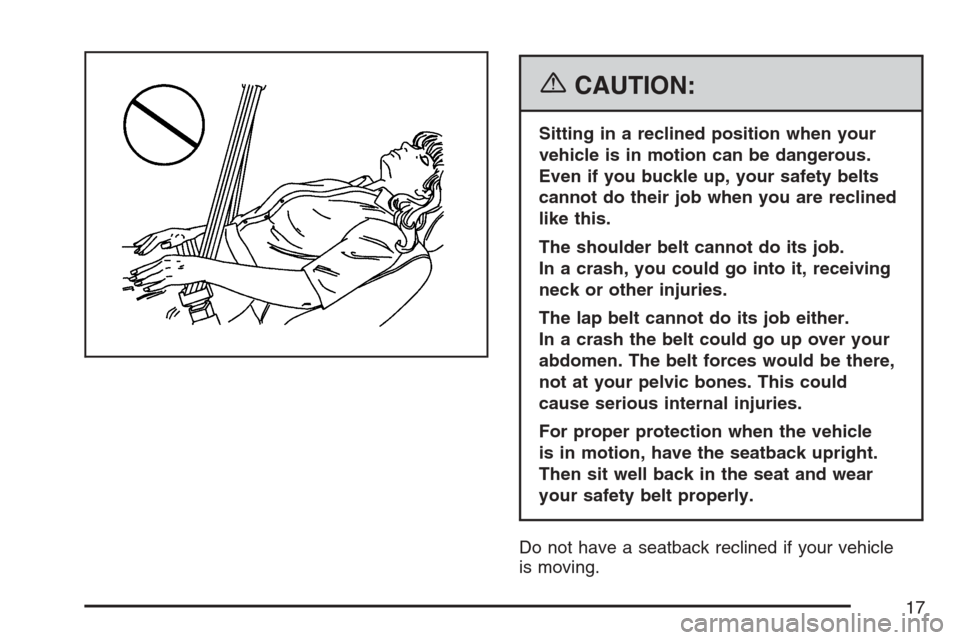
{CAUTION:
Sitting in a reclined position when your
vehicle is in motion can be dangerous.
Even if you buckle up, your safety belts
cannot do their job when you are reclined
like this.
The shoulder belt cannot do its job.
In a crash, you could go into it, receiving
neck or other injuries.
The lap belt cannot do its job either.
In a crash the belt could go up over your
abdomen. The belt forces would be there,
not at your pelvic bones. This could
cause serious internal injuries.
For proper protection when the vehicle
is in motion, have the seatback upright.
Then sit well back in the seat and wear
your safety belt properly.
Do not have a seatback reclined if your vehicle
is moving.
17
Page 18 of 618

Head Restraints
Adjust the head restraint so that the top of the
restraint is at the same height as the top of
the occupant’s head. This position reduces the
chance of a neck injury in a crash.Pull the head restraint
up to raise it. To lower
the head restraint,
press the release
button, located on the
top of the seatback,
while you push the
head restraint down.
Center Seat
Your vehicle may have a front center seat. The
seatback doubles as an armrest and cupholder/
storage area for the driver and passenger when the
center seat is not used. Do not use it as a seating
position when the seatback is folded down.
For information on safety belts for this position,
seeCenter Front Passenger Position on page 36.
18
Page 19 of 618
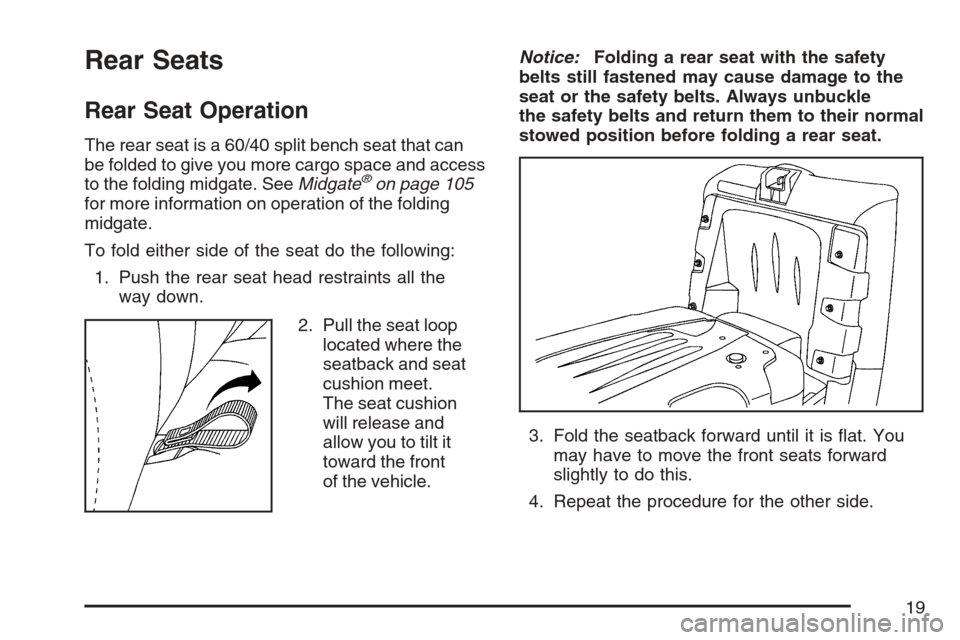
Rear Seats
Rear Seat Operation
The rear seat is a 60/40 split bench seat that can
be folded to give you more cargo space and access
to the folding midgate. SeeMidgate
®on page 105
for more information on operation of the folding
midgate.
To fold either side of the seat do the following:
1. Push the rear seat head restraints all the
way down.
2. Pull the seat loop
located where the
seatback and seat
cushion meet.
The seat cushion
will release and
allow you to tilt it
toward the front
of the vehicle.Notice:Folding a rear seat with the safety
belts still fastened may cause damage to the
seat or the safety belts. Always unbuckle
the safety belts and return them to their normal
stowed position before folding a rear seat.
3. Fold the seatback forward until it is �at. You
may have to move the front seats forward
slightly to do this.
4. Repeat the procedure for the other side.
19
Page 20 of 618

To return the seats to the normal position, push
the seatback up and fold the seat cushion down.
{CAUTION:
A safety belt that is improperly routed,
not properly attached, or twisted will not
provide the protection needed in a crash.
The person wearing the belt could be
seriously injured. After raising the rear
seatback, always check to be sure that
the safety belts are properly routed and
attached, and are not twisted.
{CAUTION:
If the seatback is not locked, it could
move forward in a sudden stop or crash.
That could cause injury to the person
sitting there. Always be sure to press the
rear of the seat cushion down. This action
locks the seatback in place.
Push and pull on the seatback to make sure
it is locked. Raise the head restraint.
20
Page 21 of 618
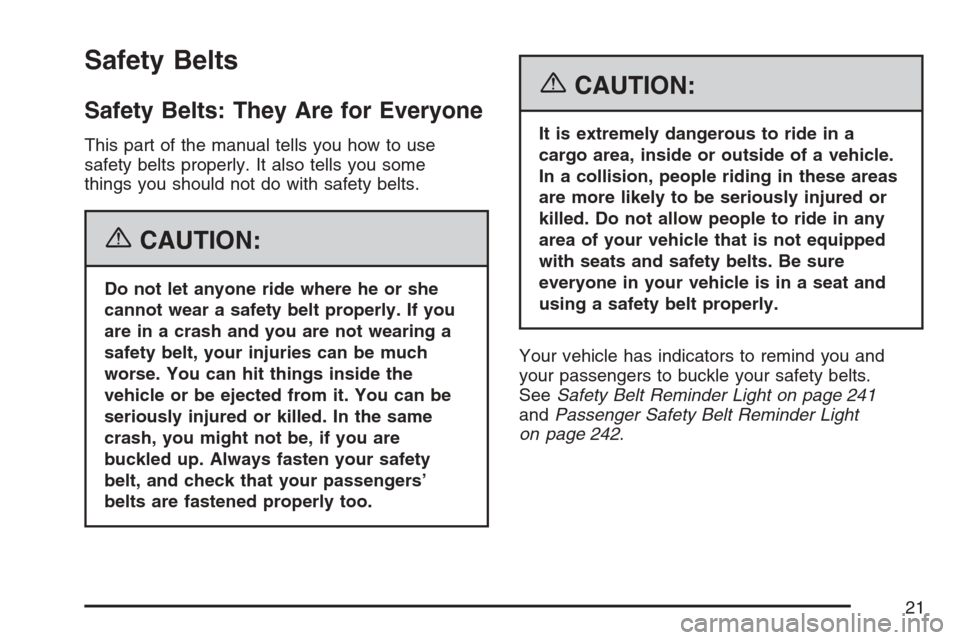
Safety Belts
Safety Belts: They Are for Everyone
This part of the manual tells you how to use
safety belts properly. It also tells you some
things you should not do with safety belts.
{CAUTION:
Do not let anyone ride where he or she
cannot wear a safety belt properly. If you
are in a crash and you are not wearing a
safety belt, your injuries can be much
worse. You can hit things inside the
vehicle or be ejected from it. You can be
seriously injured or killed. In the same
crash, you might not be, if you are
buckled up. Always fasten your safety
belt, and check that your passengers’
belts are fastened properly too.
{CAUTION:
It is extremely dangerous to ride in a
cargo area, inside or outside of a vehicle.
In a collision, people riding in these areas
are more likely to be seriously injured or
killed. Do not allow people to ride in any
area of your vehicle that is not equipped
with seats and safety belts. Be sure
everyone in your vehicle is in a seat and
using a safety belt properly.
Your vehicle has indicators to remind you and
your passengers to buckle your safety belts.
SeeSafety Belt Reminder Light on page 241
andPassenger Safety Belt Reminder Light
on page 242.
21
Page 22 of 618

In most states and in all Canadian provinces,
the law says to wear safety belts. Here is
why:They work.
You never know if you will be in a crash. If you
do have a crash, you do not know if it will be
a bad one.
A few crashes are mild, and some crashes can
be so serious that even buckled up, a person
would not survive. But most crashes are in
between. In many of them, people who buckle
up can survive and sometimes walk away.
Without belts they could have been badly hurt
or killed.
After more than 40 years of safety belts in
vehicles, the facts are clear. In most crashes
buckling up does matter... a lot!Why Safety Belts Work
When you ride in or on anything, you go as fast
as it goes.
Take the simplest vehicle. Suppose it is just a
seat on wheels.
22
Page 25 of 618
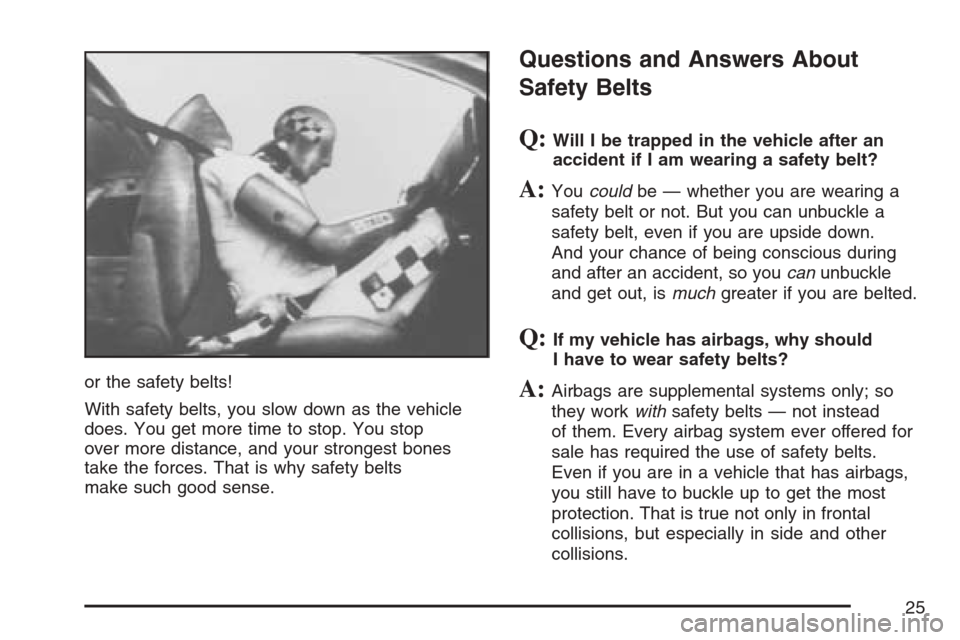
or the safety belts!
With safety belts, you slow down as the vehicle
does. You get more time to stop. You stop
over more distance, and your strongest bones
take the forces. That is why safety belts
make such good sense.
Questions and Answers About
Safety Belts
Q:Will I be trapped in the vehicle after an
accident if I am wearing a safety belt?
A:Youcouldbe — whether you are wearing a
safety belt or not. But you can unbuckle a
safety belt, even if you are upside down.
And your chance of being conscious during
and after an accident, so youcanunbuckle
and get out, ismuchgreater if you are belted.
Q:If my vehicle has airbags, why should
I have to wear safety belts?
A:Airbags are supplemental systems only; so
they workwithsafety belts — not instead
of them. Every airbag system ever offered for
sale has required the use of safety belts.
Even if you are in a vehicle that has airbags,
you still have to buckle up to get the most
protection. That is true not only in frontal
collisions, but especially in side and other
collisions.
25
Page 26 of 618
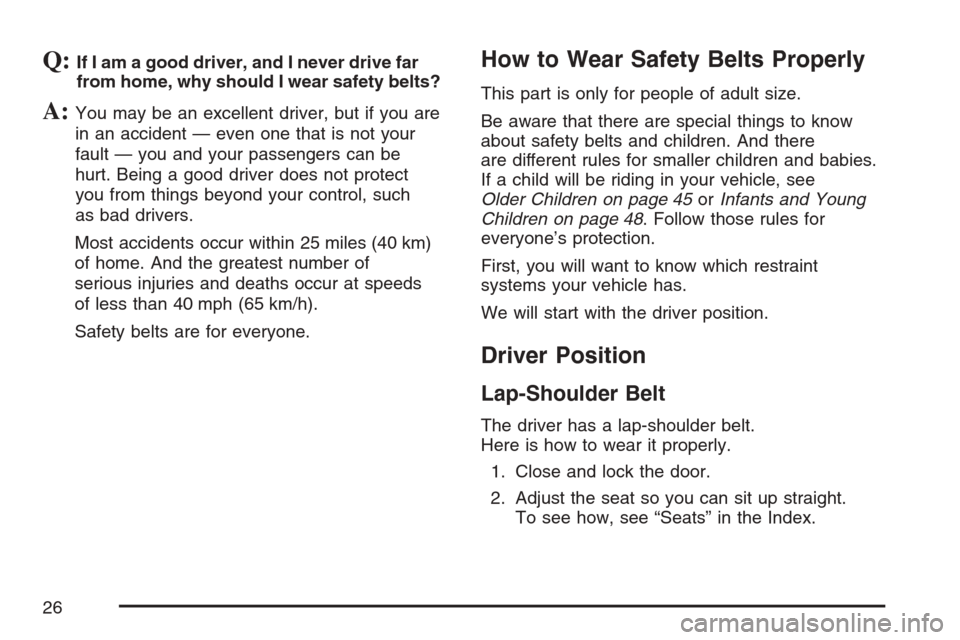
Q:If I am a good driver, and I never drive far
from home, why should I wear safety belts?
A:You may be an excellent driver, but if you are
in an accident — even one that is not your
fault — you and your passengers can be
hurt. Being a good driver does not protect
you from things beyond your control, such
as bad drivers.
Most accidents occur within 25 miles (40 km)
of home. And the greatest number of
serious injuries and deaths occur at speeds
of less than 40 mph (65 km/h).
Safety belts are for everyone.
How to Wear Safety Belts Properly
This part is only for people of adult size.
Be aware that there are special things to know
about safety belts and children. And there
are different rules for smaller children and babies.
If a child will be riding in your vehicle, see
Older Children on page 45orInfants and Young
Children on page 48. Follow those rules for
everyone’s protection.
First, you will want to know which restraint
systems your vehicle has.
We will start with the driver position.
Driver Position
Lap-Shoulder Belt
The driver has a lap-shoulder belt.
Here is how to wear it properly.
1. Close and lock the door.
2. Adjust the seat so you can sit up straight.
To see how, see “Seats” in the Index.
26